Ambulatory Procedures
Even though the anterior repair is the most commonly utilized operation for correction of a cystocele, it is probably not the most effective, nor is it the correct operation for restoring a woman's anatomy and maintaining vaginal length and function. The problem with using this operation in young healthy sexually active woman with a paravaginal defect (cystocele) is the surgeon does not really surgically support the bladder, but instead reduces the bulge by "scrunching " the fascia under the bladder together.
Table of Contents
- Anterior Repair
- Posterior Repair
- Colpocleisis (Lefort)
- Perineoplasty (reconstruct vaginal opening)
Anterior repair (colporrhaphy)
Even though the anterior repair is the most commonly utilized operation for correction of a cystocele, it is probably not the most effective, nor is it the correct operation for restoring a woman's anatomy and maintaining vaginal length and function. The problem with using this operation in young healthy sexually active woman with a paravaginal defect (cystocele) is the surgeon does not really surgically support the bladder, but instead reduces the bulge by "scrunching " the fascia under the bladder together. The anterior repair should or can be utilized in-patients with:
- Midline defects
- Defects which are not paravaginal defects
- Cystocele of any type in patient whose vaginal function and length is not important
- Cystocele of any type in sexually inactive patients
Anterior repair operations are performed through the opening of the vagina and can be performed under general, regional (spinal or epidural) or local anesthesia. Dissecting the overlying vaginal skin from the underlying pubocervical fascia begins the procedure. The defect in the fascia is identified and repaired using suture. The excess vaginal skin is removed. Often the skin stretches and only the excess should be removed. Finally the vaginal skin is closed using suture. The operation is one of the least traumatic operations performed in vaginal wall reconstruction.
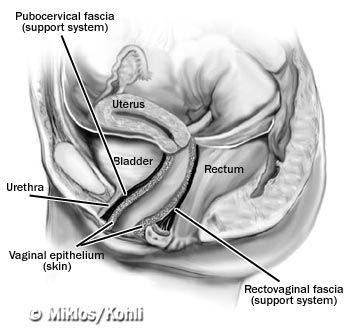
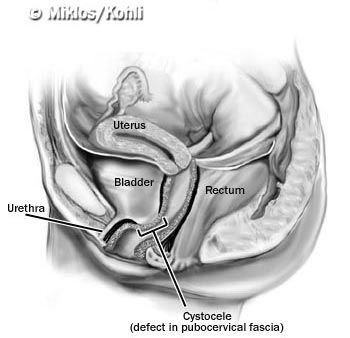
Surgical Technique of Cystocele Repair (Midline Defect only)
The following illustrate a sequence of events in the repair of a midline defect cystocele. The patient has a cystocele due to a midline break in the pubocervical fascia.
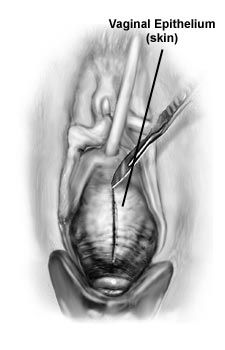

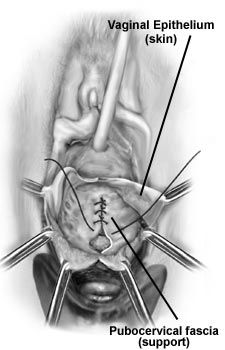
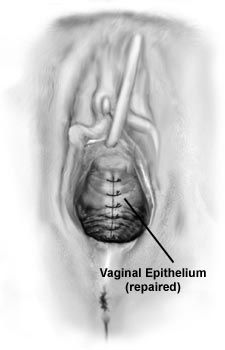
Posterior Repair (colporrhaphy)
There are many types of posterior repairs for the treatment of rectocele:
- Posterior colporrhaphy
- Levatorplasty operations
- Site specific defect repair
The posterior repair has never actually been standardized and different surgeons perform the operation differently. Most surgeons perform a posterior colporrhaphy by opening the skin of the vaginal wall and suture from side to side. This procedure attempts to reduce the overall bulge without any emphasis on the exact area of defect in the fascia.
Other surgeons overcompensate and perform a levatorplasty. The lateral muscles that create the sidewalls of the vagina are actually pulled together and sutured over top of the rectum. This surgery actually pulls the lateral wall muscles out of its normal anatomic position and creates a floor above the rectum. The muscles are acting in place of the fascia. This operation is quite effective in the treatment of the rectocele but often these patients suffer from dyspareunia (painful intercourse) following surgery. This surgery is not very anatomic and Dr. Miklos rarely performs this operation.
Dr. Miklos utilizes the site-specific posterior repair that is performed in essentially the same manner as the anterior repair. The surgery is performed through the vaginal opening. The vaginal skin is incised and the overlying skin is meticulously dissected from the underlying supportive rectovaginal fascia. The defects in the fascia are identified and repaired (site-specific fascia repair) using suture. Upon completion of the fascia defect repair the skin is closed using suture. Patients rarely complain postoperatively of painful intercourse or of a
narrow vagina.


Surgical Technique of Rectocele Repair
The following illustrate a sequence of events in the repair of a rectocele.

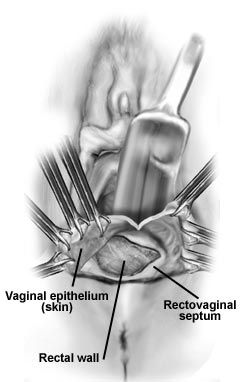
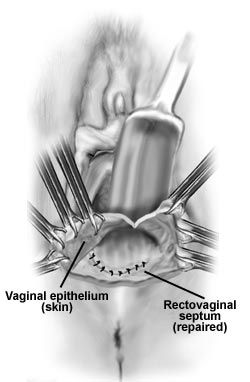
Recently, since 1998, Dr. Miklos along with Dr. Neeraj Kohli of Harvard University have been reinforcing this repair of rectovaginal fascia with a skin graft. Dr's Miklos and Kohli have elected to add the skin (dermal) graft for reinforcement in an attempt at increasing the cure rates associated with the rectovaginal fascia repair alone.
Recent studies performed in other institutions across the United States including the University of Chicago and Johns Hopkins Medical Centers reveal cure rates of approximately 80% using the site specific rectovaginal fascia repair technique (shown above). Miklos and Kohli have shown cure rates of 94% by adding the dermal graft to reinforce the area already repaired. The addition of skin graft for reinforcement is shown below.
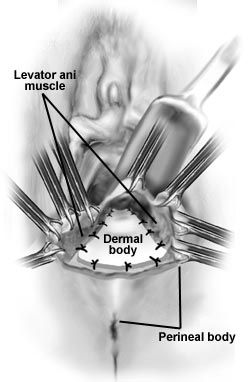
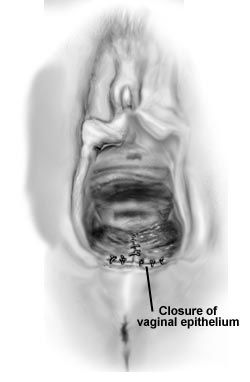
Colpocleisis (Lefort Procedure)
When patients have a uterine prolapse or vaginal vault prolapse such that the cervix or vagina apex descends past the introitus or vaginal opening there obviously has been a loss of support to this area. In a healthy, sexually active woman the vagina may be surgically attached to the sacrospinous ligament, sacrum or fascia support system. Although these reconstructive techniques are effective, they can be associated with occasional serious complications such as severe hemorrhage or major nerve injury.
In those frail elderly women who do not wish to be sexually active in the future we have found that total colpocleisis is a simple, safe, and effective surgical procedure that reliably relieves these women of their symptoms without the potential hazards of vaginal suspension. The procedure is called a total colpocleisis for patients who do not have a uterus and have complete vaginal vault prolapse and a Lefort colpocleisis for patients who still have a uterus. This procedure is often coupled with a tension free vaginal tape (TVT) sling procedure for urinary incontinence. The colpocleisis procedure is done through the vagina and essentially closes the vagina on the inside. The patient can no longer engage in sexual intercourse due to the closing up of the vagina. Colpocleisis is an extremely effective operation which:
- closes the vagina together
- inhibits a patient from future sexual intercourse
- 90-95% cure rate
- is performed using local anesthesia, epidural, spinal
- has no need for General anesthesia
- takes 45 minutes to perform
- minimal pain or complications
- can be coupled with TVT sling (incontinence) operation
Colpocleisis is an excellent operation for the treatment of uterine prolapse or complete vaginal vault prolapse for patients that are:
- not sexually active
- have no future plans for sexual activity
- medically fragile
- elderly
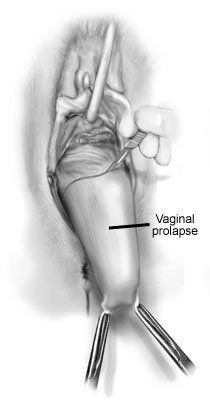


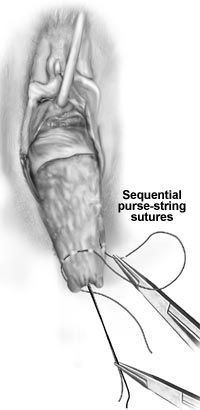
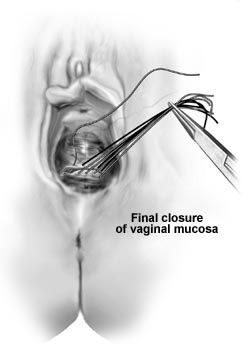

The completed procedure usually leaves the patients with a very shortened vagina... thus making the patient incapable of engaging in sexual intercourse. Dr. Miklos recommends this operation to patients who are no longer sexually active nor have plans for future sexual intercourse.
Perineoplasty
Having a baby may disrupt muscles that keep the opening of the vagina (vaginal introitus) narrow. The superficial transverse perineal muscle will often tear and retract. Patients often complain their vaginal introitus is "gaping" or sexual intercourse is not the same as it was prior to giving birth to her children.
In patients who have the above concerns or complaints and where the superficial transverse perineal muscles are no longer together, these patients are excellent candidates for perineoplasty. The goal of this surgery is to restore the normal structure of the external aspect of the vaginal opening in hope of addressing patients concerns mentioned above.
FDA approves Visby’s test for at-home STI identification
Published: March 28th 2025 | Updated: March 28th 2025The FDA has approved Visby Medical’s at-home sexually transmitted infection test, allowing women to screen for chlamydia, gonorrhea, and trichomoniasis without a prescription.
Read More
In this episode of Pap Talk, Gloria Bachmann, MD, MSc, breaks down what it means to be a health care provider for incarcerated individuals, and explores the specific challenges women and their providers face during and after incarceration. Joined by sexual health expert Michael Krychman, MD, Bachmann also discusses trauma-informed care and how providers can get informed.
Listen
